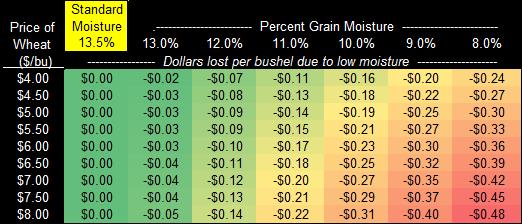by Dr. Calvin Trostle, Professor & Extension Agronomist, Lubbock, ctrostle@ag.tamu.edu;
Dr. Clark Neely, Assistant Professor & State Extension Small Grains Agronomist, cbneely@tamu.edu
The standard moisture for wheat grain at harvest time is 13.5%. If your wheat moisture is above 13.5% you will be docked for the moisture. If you are too much above standard moisture content for wheat your delivery point may reject the grain, especially if they do not have the capacity to dry grain.
Common incentives that drive harvesting wheat as soon as possible include minimizing potential storm damage every day wheat remains in the field, avoiding increasing weed issues, and possible double cropping scenarios where the sooner the next crop is in the more time it has for growth and maturation.
There is another potential downside to harvesting dry wheat—or any grain—when the crop remains in the field too long. Delayed harvest leads to further drying and final moisture percentage well below the standard content. Namely, the drier the grain, the more grain it takes to make a 60-lb. pay unit, or bushel. In effect, being able to deliver wheat grain as close as you can up to 13.5% enables you to “sell water.” Conversely, as noted above, if grain moisture is above 13.5%, you don’t get paid—you get docked.
But how much is the potential income reduction in selling wheat grain that perhaps you could have harvested sooner at slightly higher moisture? Is it a little? Is it a lot?
We have compiled a table for wheat grain with different moisture contents at a range of wheat prices ($/bu) to help you understand what the potential reduction in your effective per-bushel wheat price is as you sell further and further below 13.5%. A link to this table, entitled “Wheat Grain Moisture Calculator—Potential Income Loss” is posted under the Marketing section at http://varietytesting.tamu.edu/wheat/index.htm
You can estimate your potential reduction in effective per-bushel price for wheat <13.5% moisture from the table. Also, you can use the calculator to determine reduction in potential income per bushel with your actual %moisture and market grain price ($/bu). Furthermore, with grain yield (actual or estimated) you can also calculate your potential reduction in income per acre and per field or farm.
Example:
You harvested wheat at 11.0% moisture at a price of $4.50/bu. From the table above you find that you have effectively reduced your price $0.13/bu. At 40 bushels per acre, this is a loss of potential income of up to $5.06 per acre. And if you have 500 acres of wheat, then you could have “sold water” to the tune of $2,528.
Weather, availability of harvest equipment, etc. will dictate when you can actually harvest wheat, and no, you can’t hit 13.5% most of the time. But if by timely harvest you can sell wheat at 12.0% moisture instead of 10.0% moisture, you can preserve some income. The difference is enough to factor in your harvest management decisions to put that money in your pocket.

Calvin Trostle
Professor and Extension Specialist
Lubbock, TX
803.746.6101
ctrostle@ag.tamu.edu
